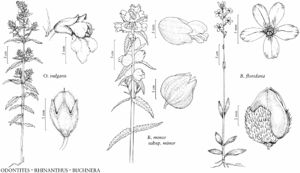Buchnera
Sp. Pl. 2: 630. 1753.
| Taxon | Illustrator ⠉ | |
|---|---|---|
 | Odontites vulgaris Rhinanthus minor subsp. minor Buchnera floridana | Yevonn Wilson-Ramsey Barbara Alongi Yevonn Wilson-Ramsey |
Herbs, biennial or perennial [annual]; hemiparasitic, caudex ca. as wide as stem, semiwoody. Stems erect, not fleshy, glabrate or hispid-hirsute. Leaves basal and cauline or cauline, opposite or subopposite; petiole absent or nearly so; blade not fleshy, not leathery, margins entire, dentate, or crenate. Inflorescences terminal, spikes or spikelike racemes; bracts present. Pedicels absent or present; bracteoles present. Flowers: sepals 5, calyx nearly radially symmetric, tubular, lobes narrowly triangular; petals 5, corolla purple, blue-purple, blue, violet, rosy, or white, bilabiate, salverform, pilose within, abaxial lobes 3, adaxial 2; stamens 4, subequal, filaments pilose; staminode 0; ovary 2-locular, placentation axile; stigma short-cylindric. Capsules: dehiscence loculicidal. Seeds ca. 250, dark-brown to blackish, cylindric-hexahedral, slightly broader at one end, wings absent. x = 20.
Distribution
North America, Mexico, West Indies, Central America, South America, Asia (Malesia), Africa, Australia
Discussion
Species ca. 100 (3 in the flora).
In some publications, the honoree of the name Buchnera is given as Johann Gottfried Büchner (1695–1749), German botanist. C. Linnaeus (1738) explicitly stated that the honoree is A. E. von Büchner. Linnaeus omitted this information in 1753 and 1754, thus perhaps opening the door to erroneous etymology.
Selected References
Lower Taxa
Key
| 1 | Leaves: blades linear to linear-lanceolate, not smaller distally; calyx tubes prominently 10-nerved. | Buchnera obliqua |
| 1 | Leaves: blades narrowly ovate, lanceolate, or narrowly oblanceolate, much smaller distally; calyx tubes obscurely 10-nerved. | > 2 |
| 2 | Leaves: larger blades narrowly ovate to lanceolate, major veins 3, minor veins (0–)2, apex acute, margins irregularly dentate, teeth 2–3 mm; corolla lobes 5–8 mm; calyces 6–8 mm. | Buchnera americana |
| 2 | Leaves: larger blades narrowly oblanceolate, lanceolate, or broadly linear, major veins 1, minor veins (0–)2, apex usually obtuse or rounded, margins entire or crenate, teeth 0.5–1.5 mm; corolla lobes 2–5 mm; calyces 4.5–5.5 mm. | Buchnera floridana |
"broader" is not a number.